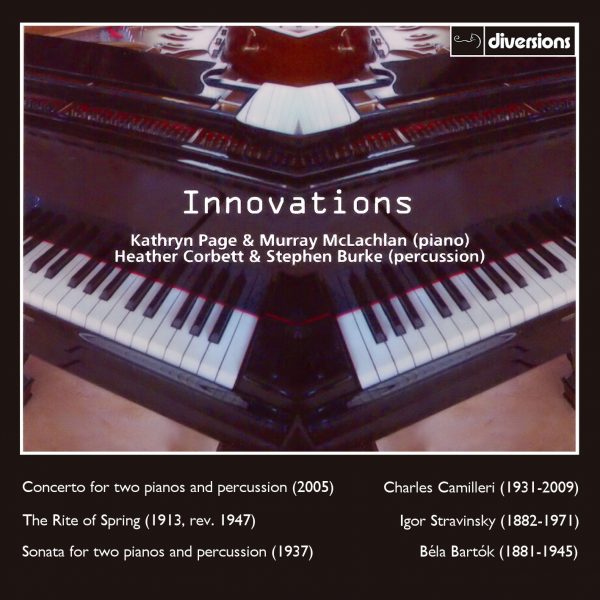Fanfare
Charles Camilleri (1931-2009) was a Maltese composer who, like Bartók, was strongly influenced by folk music, but in Camilleri’s case it was Middle Eastern folk music, heard in Malta and then Tunis when he was a child. He had long wished to write for Bartók’s instrumental combination; encouraged by pianist Murray McLachlan, Camilleri wrote this Concerto for Two Pianos and Percussion in 2004. The problem with following so unique a work—by a master—is that one cannot escape comparisons. On that front, Camilleri does well; there is little of Bartók in his concerto (probably so named to minimize comparisons). I have no experience of Middle Eastern folk music, so I cannot comment on that aspect of the concerto. Camilleri wrote: “I felt that it would be possible to write music whereby tonality, atonality, and modality would be treated as equal partners.” That’s a fair statement of what I hear in the piece. It exhibits a great deal of energy. The opening Allegro moderato is imaginative and exciting, its quiet ending leading into a slow movement that holds our attention for its full 10 minutes— no small feat. The finale blends the spirits of its predecessors. If there’s any suggestion of music of the past, it is the unavoidable Le sacre du printemps. Camilleri’s piece would make a fine partner for Bartók on a two-piano-and-percussion concert; just be sure to close with the master.
I can understand pianists wanting to play Le sacre—who isn’t fascinated by this music? I have conflicting feelings when hearing it: I am engrossed by what pianists can do with it, but I miss the color, the depth, the mystery of the original, which never loses its power to thrill. Two pianos cannot be an orchestra, and—even more so—they cannot be a primeval society sacrificing a maiden to the gods. McLachlan and Page play impressively, pouring forth cascades of notes, but they don’t catch all the rhythmic frisson and occasionally lose the thread of the quieter sections. That’s unavoidable. I’m loath to recommend any recording of the piano version, but if you must have one, try the Pekinel sisters, available on an inexpensive Deutsche Grammophon disc as well as in Decca’s 20-CD set of 38 Le sacre performances (Fanfare 36:5).
This performance of Bartók’s sonata does catch its mystery and its frisson. It is quite similar to my favorite recording, by the Casadesus family on Sony. McLachlan and Page can be a little heavy- handed compared to Robert and Gaby Casadesus, but the piece can take it. As fine as that Columbia recording was, the pianos in particular benefit from the fresh digital sound on this new disc. A reverberant acoustic adds to the warmth and color of the pianos but can confused the loudest moments. The percussion are inconsistent: they hover in the background much of the time and come bursting forth at their climactic moments. That’s always a problem in recording this piece (I don’t know why; I’ve heard no such problem in concert); one of the things that drew me to the Casadeus recording is that pianos and percussion are so well balanced..
I strongly recommend this disc (which is titled Innovations) for both the Camilleri, which is very much worth getting to know, and for the lovely performance and recording of the Bartók.
@divineartrecordingsgroup
A First Inversion Company
Registered Office:
176-178 Pontefract Road, Cudworth, Barnsley S72 8BE
+44 1226 596703
Fort Worth, TX 76110
+1.682.233.4978











![Listen to the full suite of Marcel Dupré’s Variations Sur un Noël, Op. 20 from Alexander Ffinch’s #Expectations release today! listn.fm/expectations [in bio]](https://scontent-dfw5-1.cdninstagram.com/v/t51.71878-15/588904367_2327488161082898_8709236950834211856_n.jpg?stp=dst-jpg_e35_tt6&_nc_cat=105&ccb=7-5&_nc_sid=18de74&efg=eyJlZmdfdGFnIjoiQ0xJUFMuYmVzdF9pbWFnZV91cmxnZW4uQzMifQ%3D%3D&_nc_ohc=H8WFKm530VcQ7kNvwFQrwL_&_nc_oc=AdkI5VVsHxDxjk0CxJETOnMucH4B74gdhJ6u6x-oD_AO-Z1R1Lq7fCs_j3zoEI_l9uI&_nc_zt=23&_nc_ht=scontent-dfw5-1.cdninstagram.com&edm=ANo9K5cEAAAA&_nc_gid=jxO3DCL3avXTBKPSz8T1Nw&oh=00_AfkweN3bIftfmelwm99EK8JuU8CA0TDQSxFCSfDhPS9_LA&oe=69587CAA)
